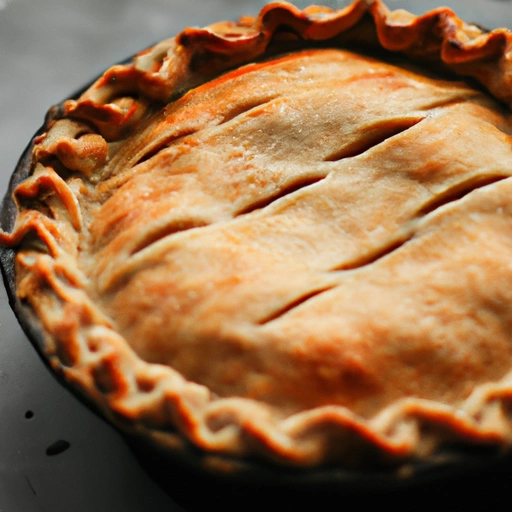Pie Pastry
Description

Pie pastry, also known as pie crust or pâte brisée, is a fundamental element in both sweet and savory baking. It is a simple blend of flour, fat, water, and occasionally sugar and salt, that when combined, creates a flaky and tender base for a variety of pies and tarts. Pie pastry can be made using a range of fats, from butter for a rich flavor to shortening or lard for extra flakiness. The proportion of ingredients and method of combining them can significantly affect the texture of the finished crust, making pie pastry a versatile and sometimes intricate component in baking.
Common uses
Pie pastry is primarily used as a base or covering for a wide variety of pies and tarts, encompassing both sweet desserts such as apple pie, pumpkin pie, and lemon meringue pie, as well as savory dishes like quiche, meat pies, and pot pies.
Nutritional value
Calories
Calories in pie pastry can vary based on the ingredients used, but a typical 1/8th slice of a 9-inch (23 cm) pie crust contains approximately 125 to 175 kcal (525 to 735 kJ).
Protein
Pie pastry generally contains around 2 to 3 grams of protein per serving, depending on the specific recipe and portion size.
Fat
The fat content in pie pastry is significant due to the use of butter, shortening, or lard, with a range of 8 to 12 grams of fat per serving.
Carbohydrates
Carbohydrates are present mostly in the form of starch from the flour, averaging 15 to 25 grams per serving.
Vitamins
Vitamins in pie pastry are minimal; however, if made with butter, it may contain small amounts of fat-soluble vitamins A and D.
Minerals
Minerals in pie pastry may include trace amounts of calcium and iron, largely coming from the enriched flour used in many recipes.
Health benefits
While pie pastry is often high in fats and carbohydrates, when consumed in moderation, it can be a source of energy. Using whole grain flours can increase its dietary fiber content, and the inclusion of butter can contribute small amounts of vitamins A and D.
Potential risks
The high fat content of pie pastry can contribute to an increased risk of heart disease if consumed excessively. Additionally, the use of refined flour leads to a spike in blood sugar levels, which can be a concern for individuals with insulin resistance or diabetes. It's also important to consider potential allergens such as gluten in wheat-based pie pastries for those with celiac disease or gluten sensitivity.
Common recipes
Common recipes using pie pastry include classic apple pie, cherry pie, pecan pie, quiche Lorraine, chicken pot pie, and beef empanadas.
Cooking methods
The cooking methods for pie pastry range from blind-baking, where the crust is pre-baked before being filled, to baking with fillings, and deep-frying for hand pies or empanadas.
Pairing with other ingredients
Pie pastry pairs well with a variety of ingredients such as fresh fruit fillings, custards, cheeses, and meats. It also complements spices like cinnamon and nutmeg in sweet pies, or thyme and rosemary in savory dishes.
Summary
Pie pastry is a key ingredient in many classic dishes, both sweet and savory. Its flaky texture and rich taste make it a beloved element in traditional baking, and with conscientious use, it can be part of a balanced diet. As an essential skill in baking, mastering pie pastry opens up a world of culinary possibilities.